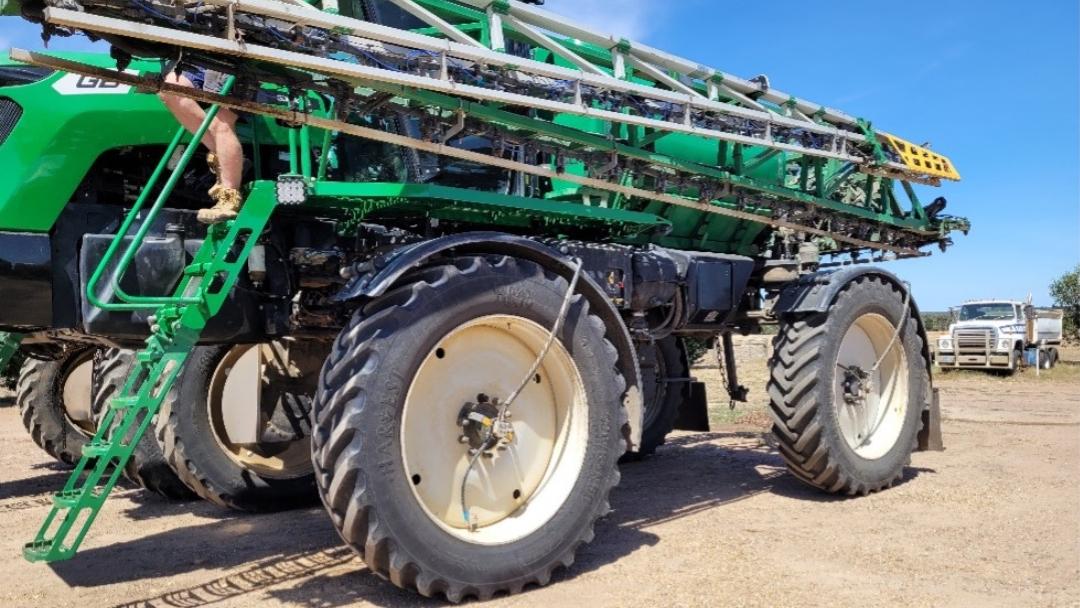IMAGE: A Goldacres SP sprayer in the western districts of Victoria fitted with CTIS that allows pressure to be reduced when spraying in the field and increased for road transport, all within a few minutes and at the touch of a button in the cab.
One crucial aspect of successful CTF implementation is effective selection and management of tyres. Key factors to consider are tyre selection, inflation management and tyre rotation and maintenance.
Tyre selection
Choosing the right agricultural tyres is critical for optimal performance. When selecting tyres for CTF, farmers should consider:
- Tyre choice: A common criteria for tyre selection is to reduce contact pressure to minimise soil compaction. Since CTF is premised on permanently compacted traffic lanes, this is of somewhat lesser concern, although it is still important to limit ground pressure to avoid damage to wheel tracks in wet conditions and to minimise soil compaction when turning on headlands where traffic paths are less defined. For CTF applications, opt for taller and/or IF (increased flexion) /VF (very high flexion) tyres to distribute the load over a larger surface area by increasing the length of the tyre footprint. This gives a bigger footprint without substantially increasing tyre width and will improve efficiency and fuel consumption. Newer tyre technologies such as IF and VF will also carry greater loads or allow reduced inflation pressure for the same tyre section width.
- Tread pattern: Select tyres with a tread pattern suitable for the specific operations and soil conditions. This will ensure good traction, minimise slip and maintain efficiency. For low torque, applications such as SP sprayers and linkage implements, a tyre with more lugs or a specific flotation style tread pattern will reduce soil disturbance and provide an improved ride. For wet conditions, a deeper and more aggressive R1W style tread may be more appropriate but will cause greater soil disturbance.
- Inflation pressure: Tyre pressure must be matched to the specific speed and load of the application. Setting the tyre pressure correctly optimises the contact footprint, reduces compaction and improves tyre life while minimising slip and fuel consumption. In slow and wet conditions, a lower pressure is better and in harder and fast conditions, tyre pressure should be increased. Tyre load capacity, reflected by load index, also plays a role in the inflation pressure required for the specific tyre. This should be considered as part of tyre upgrades along with the track width.
- Matching tyre and track widths: Matching tyre and track widths across equipment is a key factor in CTF to minimise the trafficked area. Mismatch of tyre and track widths can lead to rough rides when tyres or tracks don’t match or if the tyre/track width does not fit within the designated “tram lines”.
- Track rutting: Getting the optimum tyre set-up plays a key role in minimising track rutting, a common issue in CTF operations, especially in wet years. Other considerations to reduce track rutting are reducing load (along with speed and pressure) in wet conditions and staying off the paddock altogether in very wet periods.
Tyre inflation management
Maintaining the appropriate tyre pressure is crucial for optimising performance. All farmers should have a tyre management plan for each piece of equipment and for each application. Consider the following:
- Regular pressure checks: Inspect tyre pressure regularly to ensure it meets the recommended guidelines. Make adjustments based on field conditions, crop requirements, operating speed and equipment load. Be mindful of any additional weight carried (e.g. spray tanks) or applied by weight transfer from implements. Overloading can lead to tyre damage and early failure and excessive soil compaction if operating off the permanent wheel tracks. Tyre pressure adjustment can compensate within limits.
- CTIS or TPMS: Use pressure adjusting/monitoring technology such as central tyre inflation systems (CTIS) or tyre pressure monitoring systems (TPMS). These tools enable real-time pressure monitoring and adjustment to ensure optimum inflation pressures. CTIS can have a significant impact as it easily allows for increased pressure for road transport and reduced pressure for field operation. Without CTIS, the tyre pressure is usually set at a pressure to accommodate the most limiting combination of speed and load which significantly compromises most of the load/speed combinations experienced. This may mean a tractor, sprayer or seeding bar tyre is run in the field at a much higher pressure than required because it also needs to carry out road transport with increased speeds and loads. As this technology becomes more cost effective, the ability to instantly change pressure to suit specific applications becomes a lot more attractive. Contractors are adopting this technology first but it is becoming more widely available as an option on tractors, sprayers and harvesting equipment (headers and chaser bins). This video highlights the benefits of CTIS on a seeding bar:. https://www.ntstiresupply.com/ptk-shared/why-you-need-a-central-tire-inflation-system-for-your-planter
Tyre rotation and maintenance
- Check regularly: Maintenance checks can significantly improve the longevity and performance of agricultural tyres: check pressures and inspect tyres for signs of wear, damage or punctures regularly. Address issues promptly to prevent further damage and reduce the risk of failure during critical farming operations. Have an inflation pressure plan for each piece of equipment and where necessary for the different operations that require that piece of equipment. A tractor doing heavy tillage may require a significantly different inflation pressure compared to when it is towing a spreader or sprayer. Road transport vs field operation also needs to be considered (and set for the worst case).
- Proper storage: When not in use, store agricultural tyres in a clean, cool, and dry environment. Avoid exposure to direct sunlight, extreme temperatures, or chemicals that may deteriorate the rubber compounds.
Conclusion
Soil compaction is largely managed through the use of permanent wheel tracks in controlled traffic farming systems, but efficient management of agricultural tyres is just as important in CTF as non-CTF operations. By selecting the right tyres, maintaining proper inflation levels, implementing regular rotation and maintenance, and considering machinery and tyre size and technology, farmers can minimise soil compaction, reduce rutting, improve crop productivity and enhance the overall sustainability of their farming operations. Embracing these practices will contribute to the long-term success and viability of CTF systems and reduce the running costs of your farming business.
For further information or assistance, please contact Matt Petersen at Tyre Traders on matt@tyretraders.com.au or 1300 761 802.

